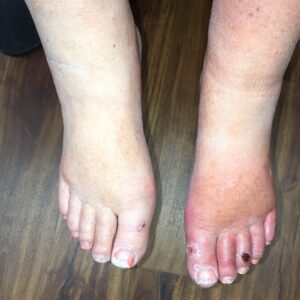Peripheral arterial disease is a condition that results from the build-up of plaque (atherosclerosis) within the arteries, primarily in the lower extremities, resulting in decreased blood flow to the legs, feet and toes. Most people are aware of coronary artery disease (CAD), which is atherosclerosis of the arteries within the heart, but most people have not heard of PAD. There is a connection between them, and an understanding of PAD may help reduce the risk of lower extremity amputation, heart attack, stroke and death.
The signs and symptoms of PAD begin gradually and can easily be overlooked, misinterpreted and attributed to other conditions. Common symptoms of PAD include pain in the lower extremities, specifically the calf or buttocks, that occurs with walking. The pain resolves with cessation of walking and returns with resumption of walking. Persons with PAD will often describe a specific distance they are able to walk before the onset of pain, such as two city blocks or 50 feet. Symptoms may be seen in one or both lower extremities. Distance varies per individual and the symptoms are often so gradual in their onset, that persons with PAD often become accustomed to living with pain.
Impotence in men can be a sign of advanced PAD as can the inability of a person to elevate their lower extremities without pain. People with advance PAD will often sleep with a foot or both feet dangling from the side of their bed or may sleep sitting up as they have less pain in such positions, enlisting gravity to assist in brining more blood flow to their legs and feet. Other advanced symptoms may include numbness, tingling in the feet, increased redness or a bluish discoloration to the feet when in a dependent (think dangling feet off the side of the bed). The development of painful sores or ulcers on the toes, feet or legs are often seen in advanced PAD as well.
Anyone who is over the age of 50 who is diabetic, smokers and those over the age of 70 are at the greatest risk for developing peripheral arterial disease and should be screened annually per the American College of Cardiology and the American Heart Association. Many diabetics suffer from peripheral neuropathy, a nerve condition that can cause among its symptoms, numbness and tingling in the feet. Advanced PAD has similar symptoms and can be misdiagnosed as peripheral neuropathy, therefore anyone exhibiting such symptoms must be evaluated for peripheral arterial disease.
Screening and testing for PAD is simple, with non-invasive testing recommended for those at risk. PAD is progressive but medications and emerging technologies often used in the treatment of CAD have been responsible for improving the quality of life and reducing unnecessary amputations in those suffering from PAD.
Author: Dr. Desmond Bell – Chief Medical Officer at Omeza
Disclaimer: No content on this site, regardless of date, should ever be used as a substitute for direct medical advice from your doctor or other qualified clinician.


